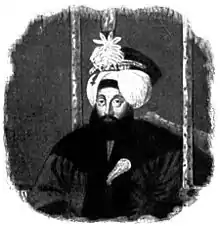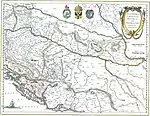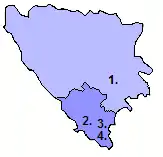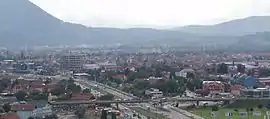Bosnian uprising (1831–32)
The Bosnian uprising (also known as Great Bosnian Uprising) was a revolt of Bosniak ayans (landlords) against the Ottoman Empire. The casus belli were reforms implemented by the Sultan to abolish the ayan system.[2]
| Great Bosnian uprising | |||||||||
|---|---|---|---|---|---|---|---|---|---|
| Part of the Rise of nationalism under the Ottoman Empire | |||||||||
| |||||||||
| Belligerents | |||||||||
|
|
| ||||||||
| Commanders and leaders | |||||||||
|
|
| ||||||||
| Strength | |||||||||
| unknown | 25,000[1] | ||||||||
| Casualties and losses | |||||||||
| unknown | unknown | ||||||||
Despite winning several notable victories, the rebels were eventually defeated in a battle near Sarajevo in 1832. Internal discord contributed to the failure of the rebellion, because Gradaščević was not supported by much of the Herzegovinian nobility.
As a result, Ali-paša Rizvanbegović was named pasha of the Herzegovina Eyalet which was seceded in 1833. The Sultan implemented the new muselim system, abolishing the old ayan system. The new muselims were mostly old ayans, but in 1850 Omer Pasha completely eliminated old ayan families.[2]
The road to uprising

In the late 1820s, Sultan Mahmud II reintroduced a set of reforms that called for further expansion of the centrally controlled army (nizam), new taxes and more Ottoman bureaucracy. These reforms weakened the special status and privileges Bosnian beys had enjoyed under the Ottoman Empire and coupled with the growing power and position of other European people under Ottoman control caused much anger and alarm. Contrary to popular belief, however, the future leader of the autonomy movement, Husein Gradaščević, then just a local official, was not greatly opposed to these reforms.
In 1826, when the Sultan issued a decree abolishing the janissaries in Bosnia, Gradaščević's immediate reaction was not unlike that of the rest of the Bosnian aristocracy. Gradaščević threatened that he would use military force to subdue anybody opposed to the Sarajevo janissaries. When the janissaries killed nakibul-ešraf Nuruddin Efendi Šerifović, however, his tone shifted and he rapidly distanced himself from their cause.
For the rest of the 1820s, Gradaščević generally maintained good relations with imperial authorities in Bosnia. When Abdurrahim-paša became vizier in 1827, Gradaščević was said to have become one of his more trusted advisors. This culminated in Gradaščević's large role in the Bosnian mobilization for the Russo-Ottoman war. Following a riot in the Sarajevo camp during these preparations, Gradaščević even provided shelter for the ousted Abdurrahim-paša in Gradačac before assisting him in his escape from the country. Gradaščević was also relatively loyal to Abdurrahim's successor, Namik-paša, reinforcing Ottoman garrisons in Šabac upon his orders.
The turning point for Gradaščević came with the end of the Russo-Ottoman War of 1828–1829 and the Treaty of Adrianople on 14 September 1829. According to the provisions of the treaty and a subsequent Hatt-i Sharif, the Ottoman Empire granted suzerainty to Serbia as a result of the Serbian revolution.[3][4][5] In a move that outraged Bosniaks and launched numerous protests, newly autonomous Serbia was also given six districts (Bosnian: nahijas) that had traditionally belonged to Bosnia. Following this move, seen as the confiscation of historically Bosnian lands, the Bosnian autonomy movement was born.
Between 20 and 31 December 1830, Gradaščević hosted a gathering of Bosniak aristocrats in Gradačac. A month later, from 20 January to 5 February, another meeting was held in Tuzla to prepare for the revolt. From there, a call was issued to the Bosnian populace asking them to rise up to the defense of Bosnia. It was then that the popular Husein-kapetan was unofficially chosen to head the movement.
Rising tide and early successes
Part of a series on the |
|---|
| History of Bosnia and Herzegovina |
 |
|
|
Another outcome of the Tuzla meeting was an agreement that another general meeting should be held in Travnik. Since Travnik was the seat of the Bosnian pashaluk and the vizier, the planned meeting was in effect a direct confrontation with Ottoman authority. Gradaščević thus asked all involved to help assemble an army beforehand. On 29 March 1831, Gradaščević set out towards Travnik with some 4,000 men.

Upon hearing word of the oncoming force, Namik-paša is said to have gone to the Travnik fort and called the Sulejmanpašić brothers to his aid. When the rebel army arrived in Travnik they fired several warning shots at the castle, warning the vizier that they were prepared for a military encounter. Meanwhile, Gradaščević sent a detachment of his forces, under the command of Memiš-aga of Srebrenica, to meet Sulejmanpašić's reinforcements.
The two sides met at Pirot, on the outskirts of Travnik, on 7 April. There, Memiš-aga defeated the Sulejmanpašić brothers and their 2,000-man army, forcing them to retreat and destroying the possessions of the Sulejmanpašić family. On 21 May, Namik-paša fled to Stolac following a short siege. Soon afterwards, Gradaščević proclaimed himself the Commander of Bosnia, chosen by the will of the people.
Gradaščević made a call on 31 May demanding that all aristocrats immediately join his army, along with all from the general populace who wished to do so. Thousands rushed to join him, among them numerous Christians, who were said to comprise up to a third of his total forces. Gradaščević split his army in two, leaving one part of it in Zvornik to defend against a possible Serbian incursion. With the bulk of the troops he set out towards Kosovo to meet the grand vizier, who had been sent with a large army to quell the rebellion. Along the way, he took the cities of Peć and Pristina, where he set up his main camp.
The encounter with Grand Vizier Mehmed Rashid-paša happened on 18 July near Shtimje/Štimlje. Although both armies were of roughly equal size, the Grand Vizier's troops had superior arms. Gradaščević sent a part of his army under the command of Ali-beg Fidahić ahead to meet Rashid-paša 's forces. Following a small skirmish, Fidahić feigned a retreat. Thinking that victory was within reach, the Grand Vizier foolishly sent his cavalry and artillery into forested terrain. Gradaščević immediately took advantage of this tactical error and executed a punishing counterattack with the bulk of his forces, almost completely annihilating the Ottoman forces. Rashid-paša himself was injured and barely escaped with his life.

Rebel government established
Following claims from the Grand Vizier that the Sultan would meet all Bosniak demands if the rebel army would return to Bosnia, Gradaščević and his army turned back home. On 10 August a meeting of all major figures in the movement for autonomy was held in Pristina. At this meeting it was decided that Gradaščević should be declared vizier of Bosnia.
Although Gradaščević refused at first, those around him insisted and he eventually accepted the honor. His new status was made official during an all-Bosnian congress held in Sarajevo on September 12. In front of the Emperor's Mosque, those present swore on the Qur'an to be loyal to Gradaščević and declared that, despite potential failure and death, there would be no turning back.
At this point, Gradaščević was not only the supreme military commander, but Bosnia's leading civilian authority as well. He established a court around him, and after initially making himself at home in Sarajevo, he moved the center of Bosnian politics to Travnik, making it the de facto capital of the rebel state.
In Travnik, he established a Divan, a Bosnian congress, which together with him made up the Bosnian government. Gradaščević also collected taxes at this time, and executed various local opponents of the autonomy movement. He gained a reputation as a hero and a strong, brave, and decisive ruler. One anecdote that illustrates this is Husein-kapetan's alleged response to whether he was scared of waging war against the Ottoman Empire. God I fear slightly, Gradaščević replied, the Sultan not at all, and the Grand Vizier no more than my own horse.[6]

Opposition to the uprising in Herzegovina
During this lull in armed conflict with the Ottomans, attention was turned to the autonomy movement's strong opposition in Herzegovina. A small campaign was launched against the region from three different directions:
- 1. An army from Sarajevo was ordered to attack Stolac for a final encounter with Namik-paša, who had fled there following Gradaščević's capture of Travnik.
- 2. An army from Krajina was to assist the Sarajevan forces in this endeavor.
- 3. Armies from Posavina and south Podrinje were to attack Gacko and local captain Smail-aga Čengić.
As it happened, Namik-paša had already abandoned Stolac, so this attack was put on hold. The attack on Gacko was a failure as the forces from Posavina and south Podrinje were defeated by Čengić's troops. There was one success, however; in October, an army Gradaščević had deployed under the command of Ahmed-beg Resulbegović had taken over Trebinje from Resulbegović's loyalist cousins and other supporters of the Stolac opposition.
A Bosnian delegation reached the Grand Vizier's camp in Skopje in November of that year. The Grand Vizier promised this delegation that he would insist to the Sultan that he accept the Bosniak demands and appoint Gradaščević as the official vizier of an autonomous Bosnia. His true intentions, however, were manifested by early December when he attacked Bosnian units stationed on the outskirts of Novi Pazar. Yet again, the rebel army handed a defeat to the imperial forces. Due to a particularly strong winter though, the Bosnian troops were forced to return home.
Meanwhile, in Bosnia, Gradaščević decided to carry on his campaign in Herzegovina despite the unfavorable climate. The captain of Livno, Ibrahim-beg Fidrus, was ordered to launch a final attack against the local captains and to thus end all domestic opposition to the autonomy movement. To achieve this, Fidrus first attacked Ljubuški and the local captain Sulejman-beg. In a significant victory, Fidrus defeated Sulejman-beg and secured the whole of Herzegovina except Stolac in the process. Unfortunately, the segment of the army that laid siege to Stolac itself met with failure in early March of the next year. Receiving information that the Bosnian ranks were depleted due to the winter, the captain of Stolac Ali-paša Rizvanbegović broke the siege, counterattacking the rebels and dispersing their forces. A force had already been sent towards Stolac from Sarajevo, under the command of Mujaga Zlatar, but was ordered back by Gradaščević on March 16 after he received news of a major offensive on Bosnia being planned by the Grand Vizier.

Ottoman Counter-attack
The Ottoman campaign began in early February. The Grand Vizier sent two armies: one from Vučitrn and one from Shkodër. Both armies headed toward Sarajevo, and Gradaščević sent an army of around 10,000 men to meet them. When the Vizier's troops succeeded in crossing the Drina, Gradaščević ordered 6,000 men under Ali-paša Fidahić to meet them in Rogatica while units stationed in Višegrad were to head to Pale on the outskirts of Sarajevo. The encounter between the two sides finally happened on the Glasinac plains to the east of Sarajevo, near Sokolac, at the end of May. The Bosnian army was led by Gradaščević himself, while the Ottoman troops were under the command of Kara Mahmud Hamdi-paša, the new imperially recognized vizier of Bosnia. In this first encounter, Gradaščević was forced to retreat to Pale. The fighting continued in Pale and Gradaščević was once again forced to retreat; this time to Sarajevo. There, a council of captains decided that the fight would continue.
Defeat at Battle of Stup
The final battle was played out on 4 June at Stup, a small locality on the road between Sarajevo and Ilidža. After a long, intense battle, it seemed Gradaščević had once again defeated the Sultan's army. Near the very end, however, Herzegovinian troops under the command of Ali-paša Rizvanbegović and Smail-aga Čengić broke through defenses Gradaščević had set up on his flank and joined the fighting. Overwhelmed by the unexpected attack from behind, the rebel army was forced to retreat into the city of Sarajevo itself. It was decided that further military resistance would be futile. Gradaščević fled to Gradačac as the imperial army entered the city on 5 June and prepared to march on Travnik. Upon realizing the difficulties that his home and family would experience if he stayed there, Gradaščević decided to leave Gradačac and continue on to Austrian lands instead.
See also
References
- Milan Prelog, Povijest Bosne u doba osmanlijske vlade II, p. 41.
- Sućeska 1985, p. 81.
- English translation: Leopold Ranke, A History of Serbia and the Serbian Revolution. Translated from the German by Mrs Alexander Kerr (London: John Murray, 1847)
- http://staff.lib.msu.edu/sowards/balkan/lecture5.html
- L. S. Stavrianos, The Balkans since 1453 (London: Hurst and Co., 2000), p. 248–250.
- Senaid Hadžić, Bosna i Hercegovina u vrijeme pojave (veliko)nacionalnih ideja, Tuzla, 2016, p. 98